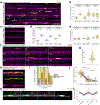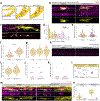Microglia phagocytose myelin sheaths to modify developmental myelination
- PMID: 32632287
- PMCID: PMC7483351
- DOI: 10.1038/s41593-020-0654-2
Microglia phagocytose myelin sheaths to modify developmental myelination
Abstract
During development, oligodendrocytes contact and wrap neuronal axons with myelin. Similarly to neurons and synapses, excess myelin sheaths are produced and selectively eliminated, but how elimination occurs is unknown. Microglia, the resident immune cells of the central nervous system, engulf surplus neurons and synapses. To determine whether microglia also prune myelin sheaths, we used zebrafish to visualize and manipulate interactions between microglia, oligodendrocytes, and neurons during development. We found that microglia closely associate with oligodendrocytes and specifically phagocytose myelin sheaths. By using a combination of optical, genetic, chemogenetic, and behavioral approaches, we reveal that neuronal activity bidirectionally balances microglial association with neuronal cell bodies and myelin phagocytosis in the optic tectum. Furthermore, multiple strategies to deplete microglia resulted in oligodendrocytes maintaining excessive and ectopic myelin. Our work reveals a neuronal activity-regulated role for microglia in modifying developmental myelin targeting by oligodendrocytes.
Conflict of interest statement
Figures












Similar articles
-
Individual oligodendrocytes have only a few hours in which to generate new myelin sheaths in vivo.Dev Cell. 2013 Jun 24;25(6):599-609. doi: 10.1016/j.devcel.2013.05.013. Dev Cell. 2013. PMID: 23806617 Free PMC article.
-
Oligodendrocyte Development in the Absence of Their Target Axons In Vivo.PLoS One. 2016 Oct 7;11(10):e0164432. doi: 10.1371/journal.pone.0164432. eCollection 2016. PLoS One. 2016. PMID: 27716830 Free PMC article.
-
Developmental exposure to domoic acid targets reticulospinal neurons and leads to aberrant myelination in the spinal cord.Sci Rep. 2023 Feb 14;13(1):2587. doi: 10.1038/s41598-023-28166-2. Sci Rep. 2023. PMID: 36788234 Free PMC article.
-
[Myelination, demyelination and re-myelination in the central nervous system].Arq Neuropsiquiatr. 1988 Sep;46(3):292-7. doi: 10.1590/s0004-282x1988000300010. Arq Neuropsiquiatr. 1988. PMID: 3066310 Review. Portuguese.
-
[Neuroglia--living nerve glue].Fortschr Neurol Psychiatr. 2011 Oct;79(10):588-97. doi: 10.1055/s-0031-1281704. Epub 2011 Oct 11. Fortschr Neurol Psychiatr. 2011. PMID: 21989511 Review. German.
Cited by
-
The Missing Piece? A Case for Microglia's Prominent Role in the Therapeutic Action of Anesthetics, Ketamine, and Psychedelics.Neurochem Res. 2023 Apr;48(4):1129-1166. doi: 10.1007/s11064-022-03772-0. Epub 2022 Nov 3. Neurochem Res. 2023. PMID: 36327017 Review.
-
Microglia morphophysiological diversity and its implications for the CNS.Front Immunol. 2022 Oct 19;13:997786. doi: 10.3389/fimmu.2022.997786. eCollection 2022. Front Immunol. 2022. PMID: 36341385 Free PMC article. Review.
-
Oligodendrocyte Dysfunction in Amyotrophic Lateral Sclerosis: Mechanisms and Therapeutic Perspectives.Cells. 2021 Mar 5;10(3):565. doi: 10.3390/cells10030565. Cells. 2021. PMID: 33807572 Free PMC article. Review.
-
Myelination generates aberrant ultrastructure that is resolved by microglia.J Cell Biol. 2023 Mar 6;222(3):e202204010. doi: 10.1083/jcb.202204010. Epub 2023 Jan 13. J Cell Biol. 2023. PMID: 36637807 Free PMC article.
-
The Mechanism and Function of Glia in Parkinson's Disease.Front Cell Neurosci. 2022 May 26;16:903469. doi: 10.3389/fncel.2022.903469. eCollection 2022. Front Cell Neurosci. 2022. PMID: 35722618 Free PMC article. Review.
References
Publication types
MeSH terms
Grants and funding
LinkOut - more resources
Full Text Sources
Other Literature Sources
Molecular Biology Databases
Research Materials

